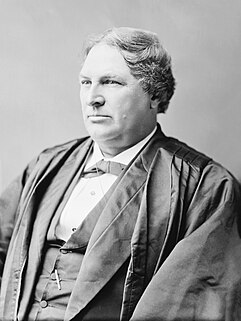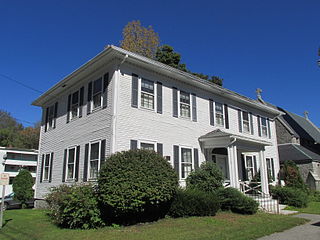
Charles Evans Hughes Sr. was an American statesman, politician and jurist who served as the 11th Chief Justice of the United States from 1930 to 1941. A member of the Republican Party, he previously was the 36th Governor of New York (1907–1910), an associate justice of the Supreme Court (1910–1916), and 44th U.S. Secretary of State (1921–1925), as well as the Republican nominee for President of the United States who lost a very close 1916 presidential election to Woodrow Wilson.

The Supreme Court of the United States is the highest-ranking judicial body in the United States. Established by Article III of the Constitution, the detailed structure of the court was laid down by the 1st United States Congress in 1789. Congress specified the Court's original and appellate jurisdiction, created 13 judicial districts, and fixed the initial size of the Supreme Court. The number of justices on the Supreme Court changed six times before settling at the present total of nine in 1869. A total of 115 justices have served on the Supreme Court since 1789. Justices have life tenure, and so they serve until they die in office, resign or retire, or are impeached and removed from office.

Stanley Forman Reed was an American lawyer and jurist who served as an Associate Justice of the U.S. Supreme Court from 1938 to 1957. He also served as U.S. Solicitor General from 1935 to 1938.

Frederick "Fred" Moore Vinson was an American attorney and politician who served as the 13th chief justice of the United States from 1946 until his death in 1953. Vinson was one of the few Americans to have served in all three branches of the U.S. government. Before becoming chief justice, Vinson served as a U.S. Representative from Kentucky from 1924 to 1928 and 1930 to 1938, as a federal appellate judge on the U.S. Court of Appeals for the District of Columbia Circuit from 1938 to 1943, and as the U.S. Secretary of the Treasury from 1945 to 1946.

Edward Douglass White Jr. was an American politician and jurist from Louisiana. White was a U.S. Supreme Court justice for 27 years, first as an associate justice from 1894 to 1910, then as the ninth chief justice from 1910 until his death in 1921. White is known for formulating the Rule of Reason standard of antitrust law.

Owen Josephus Roberts was an Associate Justice of the United States Supreme Court from 1930 to 1945. He also led two Roberts Commissions, the first of which investigated the attack on Pearl Harbor, and the second of which focused on works of cultural value during World War II.

Joseph Rucker Lamar was an Associate Justice of the United States Supreme Court appointed by President William Howard Taft. A cousin of former associate justice Lucius Lamar, he served from 1911 until his death in 1916.

Pierce Butler was an American jurist who served as an associate justice of the Supreme Court of the United States from 1923 until his death in 1939. He was a staunch conservative and was regarded as a part of the Four Horsemen, the conservative bloc that dominated the Supreme Court during the 1930s. A devout Catholic, he was the sole dissenter in the later case Buck v. Bell, though he did not write an opinion.

Samuel Freeman Miller was an American lawyer and physician who served as an associate justice of the U.S. Supreme Court from 1862 until his death in 1890.

The Supreme Court Building houses the Supreme Court of the United States. Also referred to as "The Marble Palace," the building serves as the official workplace of the Chief Justice of the United States and the eight Associate Justices of the Supreme Court. It is located at 1 First Street in Northeast Washington, D.C., in the block immediately east of the United States Capitol and north of the Library of Congress. The building is managed by the Architect of the Capitol. On May 4, 1987, the Supreme Court Building was designated a National Historic Landmark.

On October 3, 2005, Harriet Miers was nominated for Associate Justice of the U.S. Supreme Court by President George W. Bush to replace retired Associate Justice Sandra Day O'Connor. Miers was, at the time, White House Counsel, and had previously served in several roles both during Bush's tenure as Governor of Texas and President.

Thomas Ruffin (1787–1870) was an American jurist and justice of the North Carolina Supreme Court from 1829 to 1852 and again from 1858 to 1859. He was chief justice of that Court from 1833 to 1852.

The Chester A. Arthur Home was the residence of the 21st President of the United States, Chester A. Arthur (1829–1886), both before and after his four years in Washington, D.C., while serving as vice president and then as president. It is located at 123 Lexington Avenue, between 28th and 29th Streets in Rose Hill, Manhattan, New York City. Arthur spent most of his adult life living in the residence. While Vice President, Arthur retreated to the house after the July 2, 1881 shooting of President James Garfield. Arthur was in residence here when Garfield died on September 19, and took the presidential oath of office in the building. A commemorative bronze plaque was placed inside the building in 1964 by the Native New Yorkers Historical Society and New York Life Insurance, and the house was designated a National Historic Landmark on January 12, 1965.

The Ruben M. Benjamin House is a house in Bloomington, Illinois. It is a two-story rectangular building, styled in the Classical Revival architectural motif. It was built in 1856 John L. Routt, who would become the first governor of Colorado. Ruben M. Benjamin, an attorney known for litigation relating to railroad regulation, lived in the home for more than 60 years. The United States National Register of Historic Places added the Ruben M. Benjamin House in August 1978.
Washington is a neighborhood of the city of Maysville located near the Ohio River in Mason County in the U.S. state of Kentucky. It is one of the earliest settlements in Kentucky and also one of the earliest American settlements west of the Appalachian Mountains. It played a significant role in the lead-up to the Civil War, producing two civil war generals and an escaped slave whose legal case established Canada as a safe haven for escaping slaves. It also provided the site where Harriet Beecher Stowe witnessed a slave auction. It has since been annexed by Maysville, and is sometimes now referred to as Old Washington. The community is in Area 606 served by the 759 exchange.

The Washington Historic District in Washington, Kentucky was listed on the National Register of Historic Places in 1970, and its borders were increased in 1976. The buildings of Washington range from simple log cabins to late Georgian and early Federal styles constructed of home burned brick laid in Flemish Bond. Many houses have double doors at the entrance and a reeded roll length wise under a four light transom.

John Marshall was an American politician and lawyer who served as the fourth Chief Justice of the United States from 1801 until his death in 1835. He remains the longest-serving chief justice and fourth-longest serving justice in the history of the U.S. Supreme Court, and is widely regarded as one of the most influential justices ever to serve. Prior to joining the Court, Marshall served as the fourth U.S. Secretary of State under President John Adams.

Phillips' Folly is an historic three-story brick residence in Maysville, Kentucky. The home's Antebellum architecture displays a blend of styles which may be explained, in part, by the home's speculative six-year construction period, which ended with its completion in 1831. The Sutton Street entrances are Federal, windows are typical Greek Revival in their size and character, and the two-tiered portico and the segmental dormers reflect a Georgian influence. The portico and Doric frieze are similar to Drayton Hall (1738–42) near Charleston, South Carolina. The stepped parapets on the end walls are peculiar to the Ohio River Valley and are "associated with the 'Dutch' character of Cincinnati, Ohio and the surrounding area." The home also possesses an artful and unique dry stacked foundation that is set without mortar.
Lisabeth Tabor Hughes, is the Deputy Chief Justice of the Kentucky Supreme Court and is a former nominee to be a United States Circuit Judge of the United States Court of Appeals for the Sixth Circuit.

The Fuller-Weston House is a historic house at 11 Summer Street in Augusta, Maine. Built in 1818, it is a fine local example of Federal period architecture, and is further notable for several of its occupants, who include the Chief Justice of the United States Melville Fuller. The house was listed on the National Register of Historic Places in 1984. It now serves as the rectory of St. Mark's Church.




















